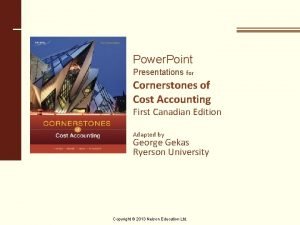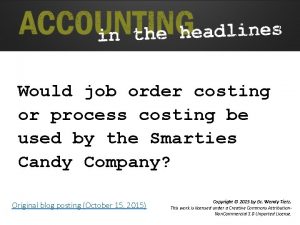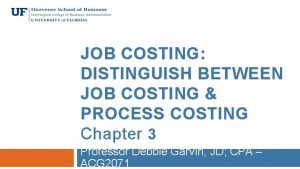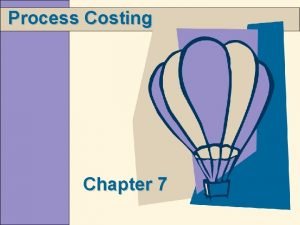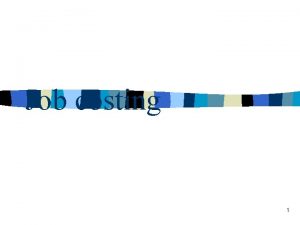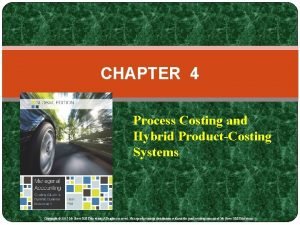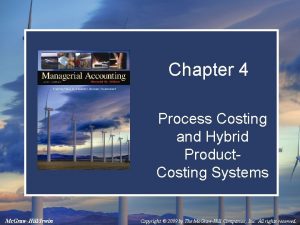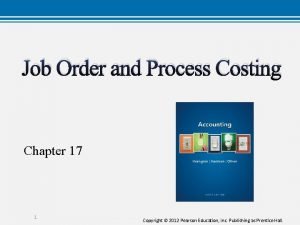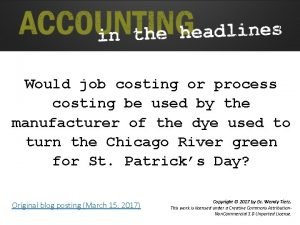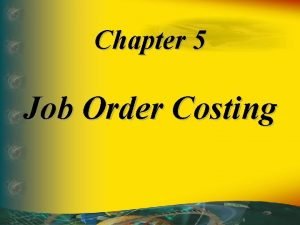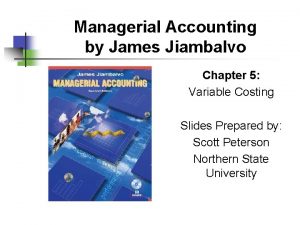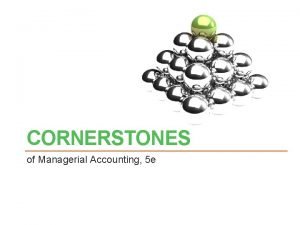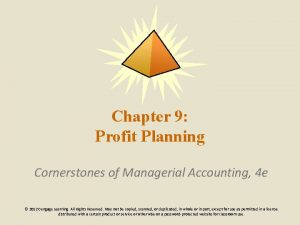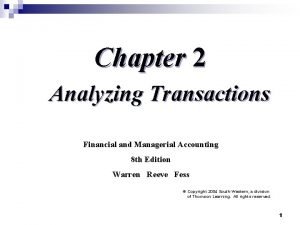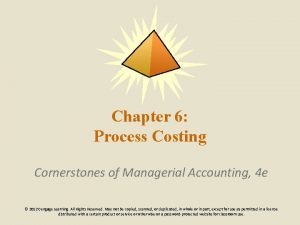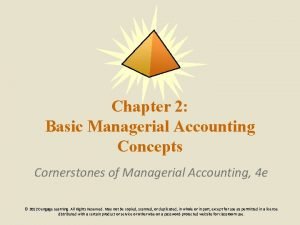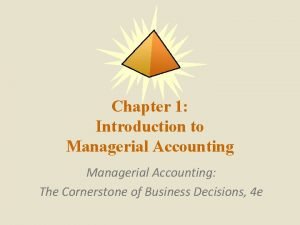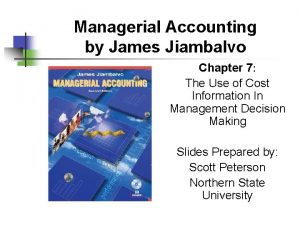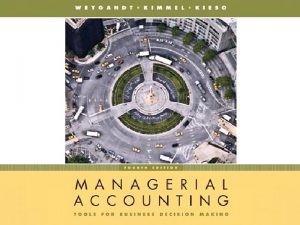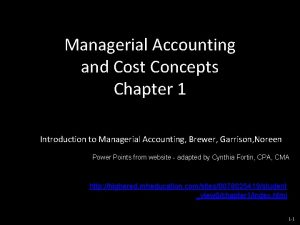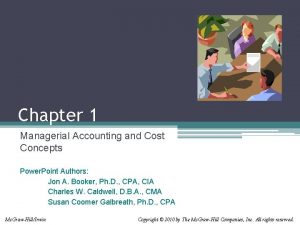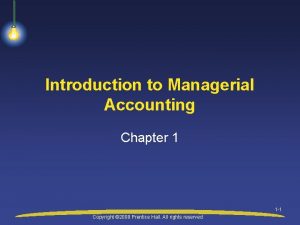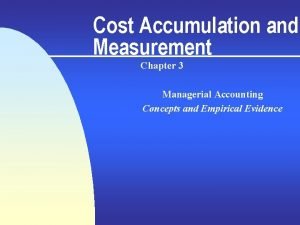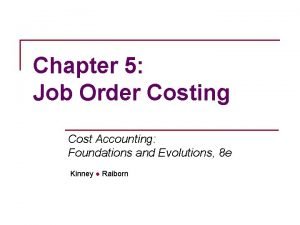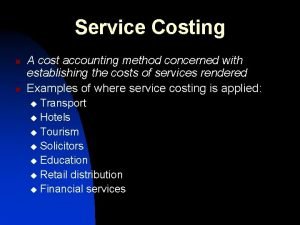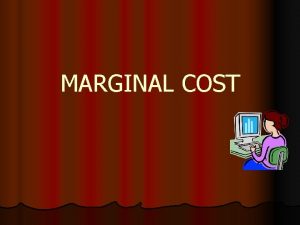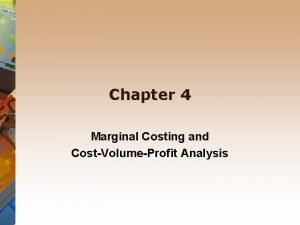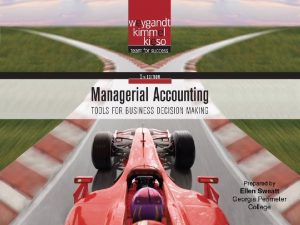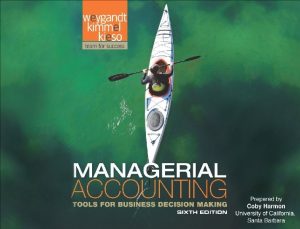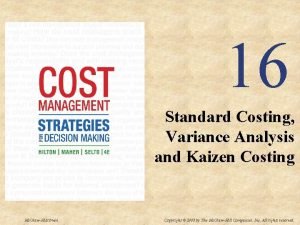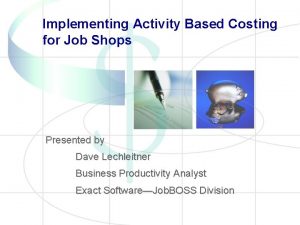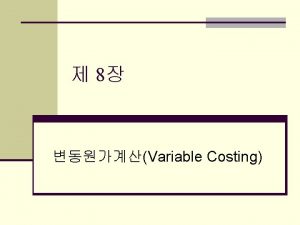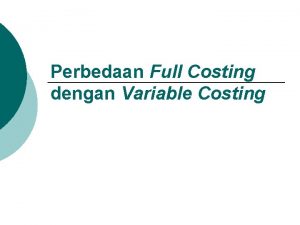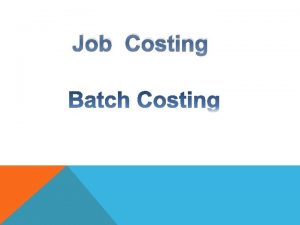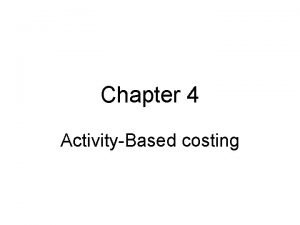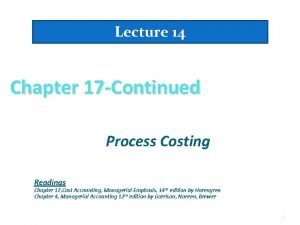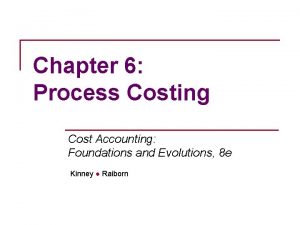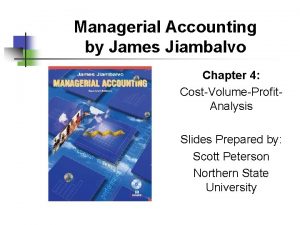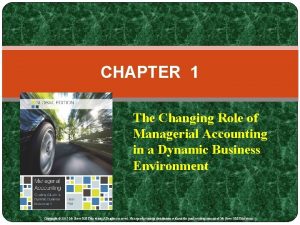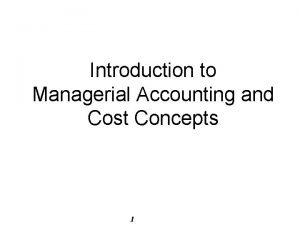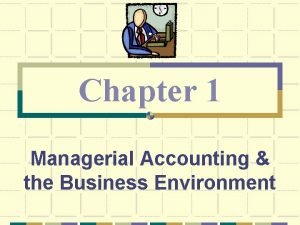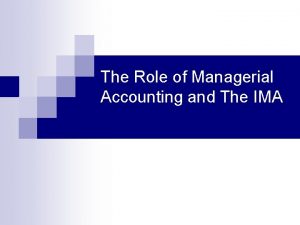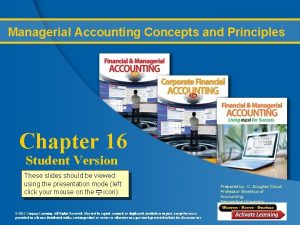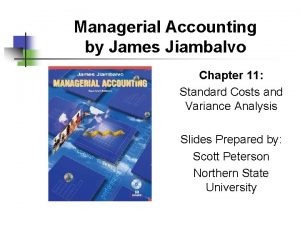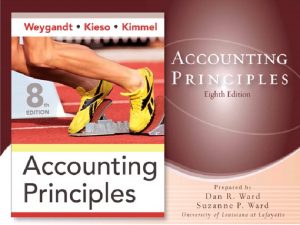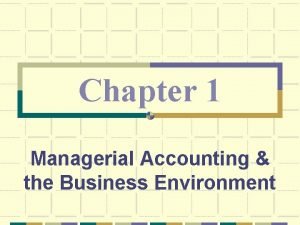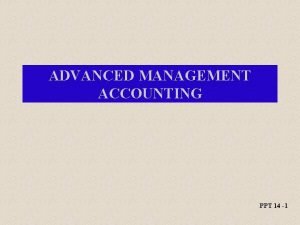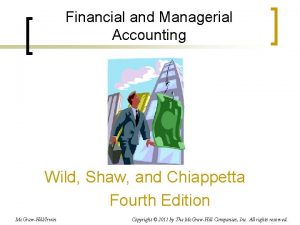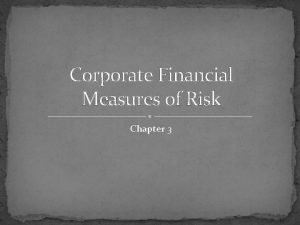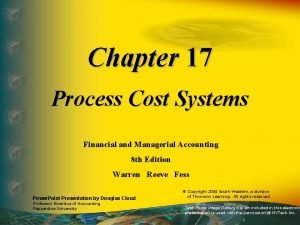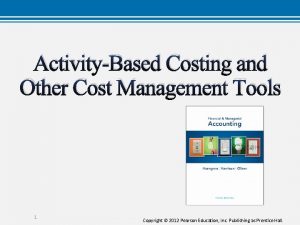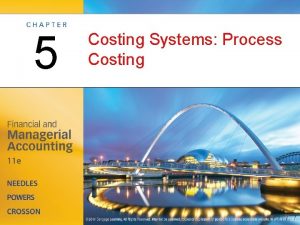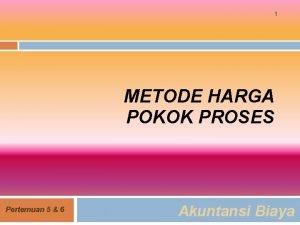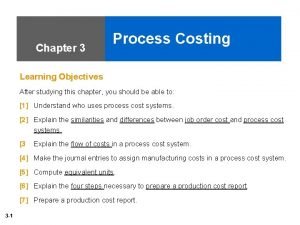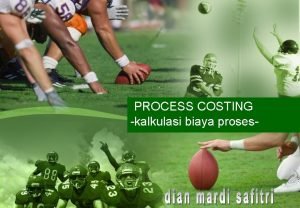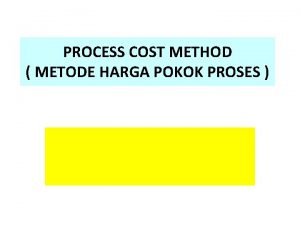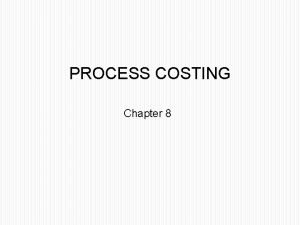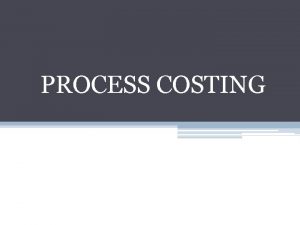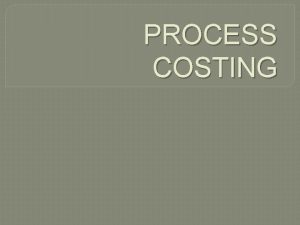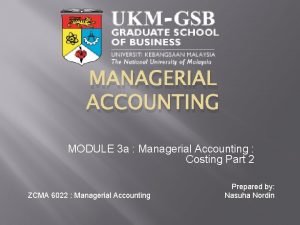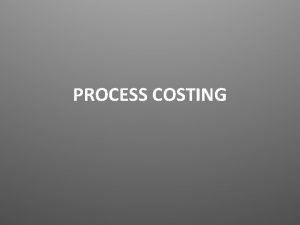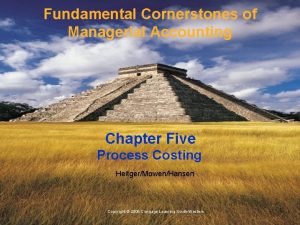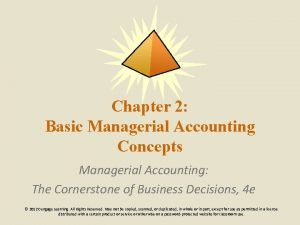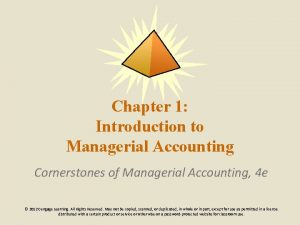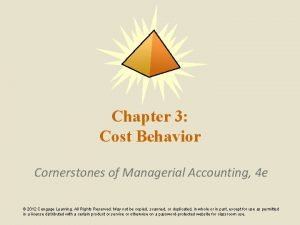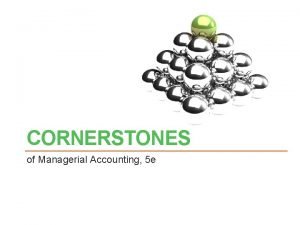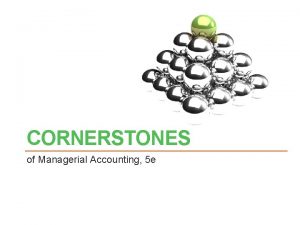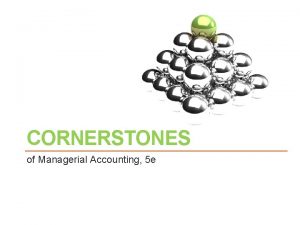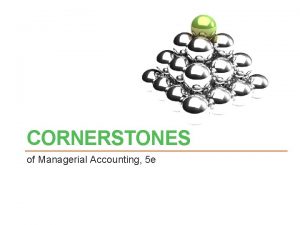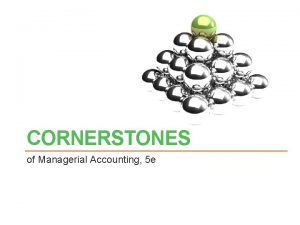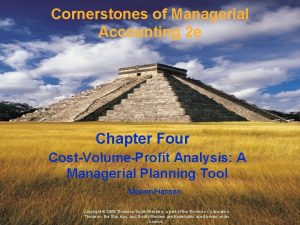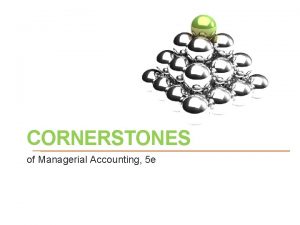Chapter 6 Process Costing Cornerstones of Managerial Accounting








































































- Slides: 72

Chapter 6: Process Costing Cornerstones of Managerial Accounting, 4 e © 2012 Cengage Learning. All Rights Reserved. May not be copied, scanned, or duplicated, in whole or in part, except for use as permitted in a license distributed with a certain product or service or otherwise on a password-protected website for classroom use.

Learning Objectives 1. Describe the basic characteristics and cost flows associated with process manufacturing. 2. Define equivalent units and explain their role in process costing. Explain the differences between the weighted average method and the FIFO method of accounting for process costs. 3. Prepare a departmental production report using the weighted average method. 4. Explain how nonuniform inputs and multiple processing departments affect process costing. 5. (Appendix 6 A) Prepare a departmental production report using the FIFO method. © 2012 Cengage Learning. All Rights Reserved. May not be copied, scanned, or duplicated, in whole or in part, except for use as permitted in a license distributed with a certain product or service or otherwise on a password-protected website for classroom use.

1 Characteristics of Process Manufacturing ►Since each product within a product line passing through the processes would receive similar ‘‘doses’’ of materials, labor, and overhead, costs are accumulated by process. ►Process costing works well whenever relatively homogeneous products pass through a series of processes and receive similar amounts of manufacturing costs. © 2012 Cengage Learning. All Rights Reserved. May not be copied, scanned, or duplicated, in whole or in part, except for use as permitted in a license distributed with a certain product or service or otherwise on a password-protected website for classroom use.

1 Types of Processes ► Sequential processing requires that units pass through one process before they can be worked on in the next process in the sequence. ► Parallel processing is another processing pattern that requires two or more sequential processes to produce a finished good. © 2012 Cengage Learning. All Rights Reserved. May not be copied, scanned, or duplicated, in whole or in part, except for use as permitted in a license distributed with a certain product or service or otherwise on a password-protected website for classroom use.

1 Types of Processes (continued) ► Partially completed units (e. g. , two subcomponents) can be worked on simultaneously in different processes and then brought together in a final process for completion. © 2012 Cengage Learning. All Rights Reserved. May not be copied, scanned, or duplicated, in whole or in part, except for use as permitted in a license distributed with a certain product or service or otherwise on a password-protected website for classroom use.

1 What’s In Common? ►Regardless of which processing pattern exists within a firm, all units produced share a common property. ►Units are homogeneous and subjected to the same operations for a given process and each unit produced in a period should receive the same unit cost. ►Understanding how unit costs are computed requires an understanding of the manufacturing cost flows that take place in a process-costing firm. © 2012 Cengage Learning. All Rights Reserved. May not be copied, scanned, or duplicated, in whole or in part, except for use as permitted in a license distributed with a certain product or service or otherwise on a password-protected website for classroom use.

1 How Costs Flow through the Accounts in Process Costing ► The manufacturing cost flows for a process-costing system are generally the same as those for a job-order system. ► As raw materials are purchased, the cost of these materials flows into a raw materials inventory account. Similarly, raw materials, direct labor, and applied overhead costs flow into a work-in-process (WIP) account. ► When goods are completed, the cost of the completed goods is transferred from WIP to the finished goods account. ► Finally, as goods are sold, the cost of the finished goods is transferred to the cost of goods sold account. ► The journal entries generally parallel those described in a job-order costing system. © 2012 Cengage Learning. All Rights Reserved. May not be copied, scanned, or duplicated, in whole or in part, except for use as permitted in a license distributed with a certain product or service or otherwise on a password-protected website for classroom use.

1 How Costs Flow through the Accounts in Process Costing (continued) ► Although job-order and process cost flows are generally similar, some differences exist. ► In process costing, each producing department has its own WIP account. As goods are completed in one department, they are transferred to the next department. ► The costs attached to the goods transferred out are also transferred to the next department. © 2012 Cengage Learning. All Rights Reserved. May not be copied, scanned, or duplicated, in whole or in part, except for use as permitted in a license distributed with a certain product or service or otherwise on a password-protected website for classroom use.

1 Cornerstone 6 -1 Calculating Cost Flows without Work in Process Information: ► Suppose that Healthblend decides to produce 2, 000 bottles of multivitamins with the following costs (there is no beginning or ending work-in-process for each department): Required: 1. Calculate the costs transferred out of each department. 2. Prepare journal entries that reflect these cost transfers. © 2012 Cengage Learning. All Rights Reserved. May not be copied, scanned, or duplicated, in whole or in part, except for use as permitted in a license distributed with a certain product or service or otherwise on a password-protected website for classroom use.

1 Cornerstone 6 -1 Calculating Cost Flows without Work in Process (continued) Solution: © 2012 Cengage Learning. All Rights Reserved. May not be copied, scanned, or duplicated, in whole or in part, except for use as permitted in a license distributed with a certain product or service or otherwise on a password-protected website for classroom use.

1 Accumulating Costs in the Production Report ► In process costing, costs are accumulated by department for a period of time. ► The production report is the document that summarizes the manufacturing activity that takes place in a process department for a given period of time. ► A production report contains information on costs transferred in from prior departments as well as costs added in the department such as direct ^^^^ materials, direct labor, and overhead; ^^^^ similar to the job-order cost sheet, ^^^^ it is subsidiary to the WIP account. ^^^^ © 2012 Cengage Learning. All Rights Reserved. May not be copied, scanned, or duplicated, in whole or in part, except for use as permitted in a license distributed with a certain product or service or otherwise on a password-protected website for classroom use.

1 Accumulating Costs in the Production Report (continued) ► A production report is divided into the following sections and subdivisions: Unit information section: The unit information section has two Unit ^^^^ major subdivisions: Cost • units to account for ^^^^ • units accounted for Cost information section: The cost information section has two major subdivisions: • costs to account for • costs accounted for ► A production report traces the flow of units through a department, identifies the costs charged to the department, shows the computation of unit costs, and reveals the disposition of the department’s costs for the reporting period. © 2012 Cengage Learning. All Rights Reserved. May not be copied, scanned, or duplicated, in whole or in part, except for use as permitted in a license distributed with a certain product or service or otherwise on a password-protected website for classroom use.

1 Service and Manufacturing Firms ►Any product or service that is basically homogeneous and repetitively produced can take advantage of a process-costing approach. ►Let’s look at three possibilities: services, manufacturing firms with a just-in-time (JIT) orientation, and traditional manufacturing firms. © 2012 Cengage Learning. All Rights Reserved. May not be copied, scanned, or duplicated, in whole or in part, except for use as permitted in a license distributed with a certain product or service or otherwise on a password-protected website for classroom use.

1 Service Firms and Process Costing ►It is possible for firms engaged in service production to have WIP inventories. ►For example, an accounting firm can have a batch of tax returns that are partially completed. ►Process costing for services is relatively simple. ►The total costs for the period are divided by the number of services provided to compute unit cost: © 2012 Cengage Learning. All Rights Reserved. May not be copied, scanned, or duplicated, in whole or in part, except for use as permitted in a license distributed with a certain product or service or otherwise on a password-protected website for classroom use.

1 Manufacturing Firms Using JIT ►Manufacturing firms may also operate without significant WIP inventories. ►Specifically, firms that have adopted a JIT approach try to reduce WIP inventories to very low levels. ►Furthermore, JIT firms usually structure their manufacturing so that process costing can be used to determine product costs. © 2012 Cengage Learning. All Rights Reserved. May not be copied, scanned, or duplicated, in whole or in part, except for use as permitted in a license distributed with a certain product or service or otherwise on a password-protected website for classroom use.

1 Manufacturing Firms Using JIT (continued) ►In many JIT firms, work cells are created that produce a product or subassembly from start to finish. ►Costs are collected by cell for a period of time, and output for the cell is measured for the same period. ► Unit costs are computed by dividing the costs of the period by output of the period: © 2012 Cengage Learning. All Rights Reserved. May not be copied, scanned, or duplicated, in whole or in part, except for use as permitted in a license distributed with a certain product or service or otherwise on a password-protected website for classroom use.

1 Traditional Manufacturing Firms ►On the other hand, traditional manufacturing firms may have significant beginning and ending WIP inventories. ►This causes complications in process costing due to several factors such as the presence of beginning and ending WIP inventories and different approaches to the treatment of beginning inventory cost. © 2012 Cengage Learning. All Rights Reserved. May not be copied, scanned, or duplicated, in whole or in part, except for use as permitted in a license distributed with a certain product or service or otherwise on a password-protected website for classroom use.

2 The Impact of Work-In-Process Inventories on Process Costing ►The computation of unit cost for the work performed during a period is a key part of the production report. ►This unit cost is needed both to compute the cost of goods transferred out of a department and to value ending work-in-process (EWIP) inventory. © 2012 Cengage Learning. All Rights Reserved. May not be copied, scanned, or duplicated, in whole or in part, except for use as permitted in a license distributed with a certain product or service or otherwise on a password-protected website for classroom use.

2 The Impact of Work-In-Process Inventories on Process Costing (continued) ► Conceptually, calculating the unit cost is easy—just divide total cost by the number of units produced. However, the presence of WIP inventories causes two problems: 1. Defining the units produced can be difficult, given that some units produced during a period are complete, while those in ending inventory are not. This is handled through the concept of equivalent units of production. 2. How should the costs and work of beginning work-in-process (BWIP) be treated? Should they be counted with the current period work and costs or treated separately? Two methods have been developed to solve this problem: the weighted average method and the FIFO method. © 2012 Cengage Learning. All Rights Reserved. May not be copied, scanned, or duplicated, in whole or in part, except for use as permitted in a license distributed with a certain product or service or otherwise on a password-protected website for classroom use.

2 Equivalent Units of Production ► By definition, EWIP is not complete. ► Thus, a unit completed and transferred out during the period is not identical (or equivalent) to one in EWIP inventory, and the cost attached to the two units should not be the same. ► In computing the unit cost, the output of the period must be defined, a significant issue for process costing. © 2012 Cengage Learning. All Rights Reserved. May not be copied, scanned, or duplicated, in whole or in part, except for use as permitted in a license distributed with a certain product or service or otherwise on a password-protected website for classroom use.

2 Equivalent Units of Production (continued) ► The solution is to calculate equivalent units of output. ► Equivalent units of output are the complete units that could have been produced given the total amount of manufacturing effort expended for the period under consideration. ► Determining equivalent units of output for transferred-out units is easy; a unit would not be transferred out unless it was complete. ► Thus, every transferred-out unit is an equivalent unit. ► Units remaining in EWIP inventory, however, are not complete. ► Thus, someone in production must ‘‘eyeball’’ EWIP to estimate its degree of completion. © 2012 Cengage Learning. All Rights Reserved. May not be copied, scanned, or duplicated, in whole or in part, except for use as permitted in a license distributed with a certain product or service or otherwise on a password-protected website for classroom use.

2 Cornerstone 6 -2 Calculating Equivalent Units of Production: No Beginning Work in Process © 2012 Cengage Learning. All Rights Reserved. May not be copied, scanned, or duplicated, in whole or in part, except for use as permitted in a license distributed with a certain product or service or otherwise on a password-protected website for classroom use.

2 Cornerstone 6 -2 Calculating Equivalent Units of Production: No Beginning Work in Process (continued) © 2012 Cengage Learning. All Rights Reserved. May not be copied, scanned, or duplicated, in whole or in part, except for use as permitted in a license distributed with a certain product or service or otherwise on a password-protected website for classroom use.

2 Ethical Decisions and Estimating Completeness ► Estimating the degree of completion is an act that requires judgment and ethical behavior. ► Overestimating the degree of completion will increase the equivalent units of output and decrease per-unit costs. ► This outcome, in turn, would cause an increase in both income (cost of goods sold will be less) and in assets (WIP cost will increase). ► Deliberately overestimating the degree of completion would clearly be in violation of ethical professional practice. © 2012 Cengage Learning. All Rights Reserved. May not be copied, scanned, or duplicated, in whole or in part, except for use as permitted in a license distributed with a certain product or service or otherwise on a password-protected website for classroom use.

2 Cornerstone 6 -3 Measuring Output and Assigning Costs: No Beginning Work in Process © 2012 Cengage Learning. All Rights Reserved. May not be copied, scanned, or duplicated, in whole or in part, except for use as permitted in a license distributed with a certain product or service or otherwise on a password-protected website for classroom use.

2 Two Methods of Treating Beginning Work-in-Process Inventory ►In computing a current-period unit cost for a department, two approaches have evolved for dealing with the prior-period output and prior-period costs found in BWIP: 1. The weighted average costing method and 2. The FIFO costing method. © 2012 Cengage Learning. All Rights Reserved. May not be copied, scanned, or duplicated, in whole or in part, except for use as permitted in a license distributed with a certain product or service or otherwise on a password-protected website for classroom use.

2 The Weighted Average Costing Method ► The weighted average costing method combines beginning inventory costs and work done with current-period costs and work to calculate this period’s unit cost. ► In essence, the costs and work carried over from the prior period are counted as if they belong to the current period. ► Thus, beginning inventory work and costs are pooled with current work and costs, and an average unit cost is computed and applied to both units transferred out and units remaining in ending inventory. © 2012 Cengage Learning. All Rights Reserved. May not be copied, scanned, or duplicated, in whole or in part, except for use as permitted in a license distributed with a certain product or service or otherwise on a password-protected website for classroom use.

2 The FIFO Costing Method ► The FIFO costing method separates work and costs of the equivalent units in beginning inventory from work and costs of the equivalent units produced during the current period. ► Only current work and costs are used to calculate this period’s unit cost. ► It is assumed that units from beginning inventory are completed first and transferred out. ► The costs of these units include the costs of the work done in the prior period as well as the current period costs necessary to complete the units. ► Units started in the current period are divided into two categories: 1. units started and completed and 2. units started but not finished (EWIP). ► Units in both of these categories are valued using the current period’s cost per equivalent unit. © 2012 Cengage Learning. All Rights Reserved. May not be copied, scanned, or duplicated, in whole or in part, except for use as permitted in a license distributed with a certain product or service or otherwise on a password-protected website for classroom use.

2 IMPORTANT POINT ►If product costs do not change from period to period, or if there is no BWIP inventory, the FIFO and weighted average methods yield the same results. © 2012 Cengage Learning. All Rights Reserved. May not be copied, scanned, or duplicated, in whole or in part, except for use as permitted in a license distributed with a certain product or service or otherwise on a password-protected website for classroom use.

2 You Decide Estimating the Degree of Completion Scenarios You are the cost accounting manager for a plant that produces riding lawn mowers. The plant manager receives a bonus at the end of each quarter if the plant’s income meets or exceeds the quarter’s budgeted income. The plant had no work in process at the beginning of the quarter; however, it had 2, 500 partially completed units at the end of the quarter. During the quarter, 4, 000 units were completed and sold. Manufacturing costs for the quarter totaled $2, 750, 000. The production line supervisors estimated that the units in process at the end of the quarter were 40 percent finished. Using this initial estimate, the income for the quarter was $190, 000 less than the quarter’s budgeted profit. After seeing this tentative result, the plant manager approaches you and argues that the degree of the completion is underestimated and that it should be 60 percent and not 40 percent. He explains that he personally examined the partially completed work and that 60 percent is his best guess. He would prefer that this new estimate be used. What effect does the estimated degree of completion have on the quarter’s income? Should you use the new estimate? © 2012 Cengage Learning. All Rights Reserved. May not be copied, scanned, or duplicated, in whole or in part, except for use as permitted in a license distributed with a certain product or service or otherwise on a password-protected website for classroom use.

2 You Decide Estimating the Degree of Completion Scenarios (continued) © 2012 Cengage Learning. All Rights Reserved. May not be copied, scanned, or duplicated, in whole or in part, except for use as permitted in a license distributed with a certain product or service or otherwise on a password-protected website for classroom use.

3 Weighted Average Costing ► The weighted average costing method treats beginning inventory costs and the accompanying equivalent output as if they belong to the current period. ►This is done for costs by adding the manufacturing costs in BWIP to the manufacturing costs incurred during the current period. ► The total cost is treated as if it were the current period’s total manufacturing cost. ►Similarly, beginning inventory output and current period output are merged in the calculation of equivalent units. ►Under the weighted average method, equivalent units of output are computed by adding units completed to equivalent units in EWIP. © 2012 Cengage Learning. All Rights Reserved. May not be copied, scanned, or duplicated, in whole or in part, except for use as permitted in a license distributed with a certain product or service or otherwise on a password-protected website for classroom use.

3 Cornerstone 6 -4 Measuring Output and Assigning Costs: Weighted Average Method © 2012 Cengage Learning. All Rights Reserved. May not be copied, scanned, or duplicated, in whole or in part, except for use as permitted in a license distributed with a certain product or service or otherwise on a password-protected website for classroom use.

3 Cornerstone 6 -4 Measuring Output and Assigning Costs: Weighted Average Method (continued) © 2012 Cengage Learning. All Rights Reserved. May not be copied, scanned, or duplicated, in whole or in part, except for use as permitted in a license distributed with a certain product or service or otherwise on a password-protected website for classroom use.

3 Cornerstone 6 -4 Measuring Output and Assigning Costs: Weighted Average Method (continued) © 2012 Cengage Learning. All Rights Reserved. May not be copied, scanned, or duplicated, in whole or in part, except for use as permitted in a license distributed with a certain product or service or otherwise on a password-protected website for classroom use.

Five Steps in Preparing a Production Report 3 ► The production report is subsidiary to the WIP account for a department. ► The following five steps describe the general pattern of a process-costing production report: 1. 2. 3. 4. 5. physical flow analysis calculation of equivalent units computation of unit cost valuation of inventories (goods transferred out and EWIP) cost reconciliation © 2012 Cengage Learning. All Rights Reserved. May not be copied, scanned, or duplicated, in whole or in part, except for use as permitted in a license distributed with a certain product or service or otherwise on a password-protected website for classroom use.

3 Step 1: Physical Flow Analysis ► The purpose of the physical flow analysis is to trace the physical units of production. ► Physical units are not equivalent units. ►They are units that may be in any stage of completion. ► Two calculations are needed to construct a physical flow schedule: ► ‘‘Total units to account for’’ must equal the ‘‘Total units accounted for. ’’ © 2012 Cengage Learning. All Rights Reserved. May not be copied, scanned, or duplicated, in whole or in part, except for use as permitted in a license distributed with a certain product or service or otherwise on a password-protected website for classroom use.

3 Cornerstone 6 -5 Preparing a Physical Flow Schedule © 2012 Cengage Learning. All Rights Reserved. May not be copied, scanned, or duplicated, in whole or in part, except for use as permitted in a license distributed with a certain product or service or otherwise on a password-protected website for classroom use.

3 Cornerstone 6 -5 Preparing a Physical Flow Schedule (continued) © 2012 Cengage Learning. All Rights Reserved. May not be copied, scanned, or duplicated, in whole or in part, except for use as permitted in a license distributed with a certain product or service or otherwise on a password-protected website for classroom use.

3 Step 2: Calculation of Equivalent Units ► The weighted average method treats beginning inventory units as if they were started and completed during the current period. ► Because of this, the equivalent unit schedule shown in step 2 shows only the total units completed. ► There is no need to show whether the units completed are from the month in question (July) or from BWIP as was done by Cornerstone 6 -4. © 2012 Cengage Learning. All Rights Reserved. May not be copied, scanned, or duplicated, in whole or in part, except for use as permitted in a license distributed with a certain product or service or otherwise on a password-protected website for classroom use.

3 Step 3: Computation of Unit Cost ► The weighted average method rolls back and includes the manufacturing costs associated with the units in BWIP and counts these costs as if they belong to month in question (July). ► Manufacturing costs are carried over from the prior period and treated as if they were current period costs. © 2012 Cengage Learning. All Rights Reserved. May not be copied, scanned, or duplicated, in whole or in part, except for use as permitted in a license distributed with a certain product or service or otherwise on a password-protected website for classroom use.

3 Step 4: Valuation of Inventories ►Cornerstone 6 -4 also showed how to value goods transferred out and EWIP. ►Units completed (from Step 1), equivalent units in EWIP (from Step 2), and the unit cost (from Step 3) are all needed to value both goods transferred out and EWIP. © 2012 Cengage Learning. All Rights Reserved. May not be copied, scanned, or duplicated, in whole or in part, except for use as permitted in a license distributed with a certain product or service or otherwise on a password-protected website for classroom use.

3 Step 5: Cost Reconciliation ►Finally, the cost reconciliation checks to see if the costs to account for are exactly assigned to inventories. ►Remember, the total costs assigned to goods transferred out and to EWIP must agree with the total costs in BWIP and the manufacturing costs incurred during the current period. © 2012 Cengage Learning. All Rights Reserved. May not be copied, scanned, or duplicated, in whole or in part, except for use as permitted in a license distributed with a certain product or service or otherwise on a password-protected website for classroom use.

3 Cornerstone 6 -6 Preparing a Production Report: Weighted Average Method (continued) © 2012 Cengage Learning. All Rights Reserved. May not be copied, scanned, or duplicated, in whole or in part, except for use as permitted in a license distributed with a certain product or service or otherwise on a password-protected website for classroom use.

3 Cornerstone 6 -6 Preparing a Production Report: Weighted Average Method (continued) © 2012 Cengage Learning. All Rights Reserved. May not be copied, scanned, or duplicated, in whole or in part, except for use as permitted in a license distributed with a certain product or service or otherwise on a password-protected website for classroom use.

3 Evaluation of the Weighted Average Method Advantages Disadvantages ► Unit cost computations are simplified: ►Inaccuracies in computing unit costs for current period output and for units in BWIP: Units in BWIP are treated as those of the current period and all equivalent units belong to the same category when it comes to calculating unit costs. If the unit cost in a process is relatively stable from one period to the next, the weighted average method is reasonably accurate. However, if the price of manufacturing inputs increases significantly from one period to the next, the unit cost of current output is understated, and the unit cost of BWIP units is overstated. © 2012 Cengage Learning. All Rights Reserved. May not be copied, scanned, or duplicated, in whole or in part, except for use as permitted in a license distributed with a certain product or service or otherwise on a password-protected website for classroom use.

4 Multiple Inputs and Multiple Departments ►Accounting for production under process costing gets complicated because of ►Nonuniform application of manufacturing inputs and ►Presence of multiple processing departments. © 2012 Cengage Learning. All Rights Reserved. May not be copied, scanned, or duplicated, in whole or in part, except for use as permitted in a license distributed with a certain product or service or otherwise on a password-protected website for classroom use.

4 Nonuniform Application of Manufacturing Inputs ►Assuming uniform application of conversion costs (direct labor and overhead) is not unreasonable. ►Direct labor input is usually needed throughout the process, and overhead is normally assigned on the basis of direct labor hours. ►Direct materials, on the other hand, are not as likely to be applied uniformly. ►In many instances, materials are added either at the beginning or the end of the process. © 2012 Cengage Learning. All Rights Reserved. May not be copied, scanned, or duplicated, in whole or in part, except for use as permitted in a license distributed with a certain product or service or otherwise on a password-protected website for classroom use.

4 Nonuniform Application of Manufacturing Inputs (continued) ► Different percentage completion figures for manufacturing inputs pose a problem for the calculation of equivalent units, unit cost, and valuation of EWIP (steps 2 -4). ► In such cases, equivalent unit calculations are done for each category of manufacturing input. ► Thus, equivalent units are calculated for each category of materials and for conversion cost. ► Next, a unit cost for each category is computed. The individual category costs are then used in Step 4 to cost out EWIP. ► The total unit cost is used to calculate the cost of goods transferred out in the same way as when there was only one input category. © 2012 Cengage Learning. All Rights Reserved. May not be copied, scanned, or duplicated, in whole or in part, except for use as permitted in a license distributed with a certain product or service or otherwise on a password-protected website for classroom use.

Cornerstone 6 -7 4 Calculating Equivalent Units, Unit Costs, and Valuing Inventories with Nonuniform Inputs © 2012 Cengage Learning. All Rights Reserved. May not be copied, scanned, or duplicated, in whole or in part, except for use as permitted in a license distributed with a certain product or service or otherwise on a password-protected website for classroom use.

4 Cornerstone 6 -7 Calculating Equivalent Units, Unit Costs, and Valuing Inventories with Nonuniform Inputs (continued) © 2012 Cengage Learning. All Rights Reserved. May not be copied, scanned, or duplicated, in whole or in part, except for use as permitted in a license distributed with a certain product or service or otherwise on a password-protected website for classroom use.

4 Production Report: Weighted Average Method Applying manufacturing inputs at different stages of a process poses no serious problems, though it requires more effort. © 2012 Cengage Learning. All Rights Reserved. May not be copied, scanned, or duplicated, in whole or in part, except for use as permitted in a license distributed with a certain product or service or otherwise on a password-protected website for classroom use.

4 Multiple Departments ►In process manufacturing, some departments receive partially completed goods from prior departments. ►The usual approach is to treat transferred-in goods as a separate material category when calculating equivalent units. ►Thus, the department receiving transferred-in goods would have three input categories: 1. one for the transferred-in materials 2. one for materials added 3. one for conversion costs © 2012 Cengage Learning. All Rights Reserved. May not be copied, scanned, or duplicated, in whole or in part, except for use as permitted in a license distributed with a certain product or service or otherwise on a password-protected website for classroom use.

4 Transferred-In Goods ►In dealing with transferred-in goods, two important points should be remembered. 1. The cost of this material is the cost of the goods transferred out as computed in the prior department. 2. The units started in the subsequent department correspond to the units transferred out from the prior department (assuming that there is a one-toone relationship between the output measures of both departments). © 2012 Cengage Learning. All Rights Reserved. May not be copied, scanned, or duplicated, in whole or in part, except for use as permitted in a license distributed with a certain product or service or otherwise on a password-protected website for classroom use.

4 Cornerstone 6 -8 Calculating the Physical Flow Schedule, Equivalent Units, and Unit Costs with Transferred-In Goods © 2012 Cengage Learning. All Rights Reserved. May not be copied, scanned, or duplicated, in whole or in part, except for use as permitted in a license distributed with a certain product or service or otherwise on a password-protected website for classroom use.

4 Cornerstone 6 -8 Calculating the Physical Flow Schedule, Equivalent Units, and Unit Costs with Transferred-In Goods (continued) © 2012 Cengage Learning. All Rights Reserved. May not be copied, scanned, or duplicated, in whole or in part, except for use as permitted in a license distributed with a certain product or service or otherwise on a password-protected website for classroom use.

4 Cornerstone 6 -8 Calculating the Physical Flow Schedule, Equivalent Units, and Unit Costs with Transferred-In Goods © 2012 Cengage Learning. All Rights Reserved. May not be copied, scanned, or duplicated, in whole or in part, except for use as permitted in a license distributed with a certain product or service or otherwise on a password-protected website for classroom use.

5 Appendix 6 A: Production Report. First-In, First-Out Costing ►Under the FIFO costing method, the equivalent units and manufacturing costs in BWIP are excluded from the current period unit cost calculation. ►This method recognizes that the work and costs carried over from the prior period legitimately belong to that period. © 2012 Cengage Learning. All Rights Reserved. May not be copied, scanned, or duplicated, in whole or in part, except for use as permitted in a license distributed with a certain product or service or otherwise on a password-protected website for classroom use.

5 Differences between the First-In, First. Out and Weighted Average Methods FIFO Weighted Average ► More Accurate: If changes occur in the prices of the manufacturing inputs from one period to the next. ► Better cost control ► Better pricing decisions ►Most firms use this method due to simplicity. ►FIFO has little advantage over weighted average, if unit costs are calculated for short periods. © 2012 Cengage Learning. All Rights Reserved. May not be copied, scanned, or duplicated, in whole or in part, except for use as permitted in a license distributed with a certain product or service or otherwise on a password-protected website for classroom use.

5 First-In, First-Out Method ► Since FIFO excludes prior-period work and costs, it is necessary to create two categories of completed units: 1. BWIP units (FIFO assumes that units in BWIP are completed first, before any new units are started) 2. Units started and completed during the current period ► These two categories of completed units are needed in the FIFO method so that each category can be costed correctly. ► For the units started and completed, the unit cost is obtained by dividing total current manufacturing costs by the current period equivalent output. ► However, for the BWIP units, the total associated manufacturing costs are the sum of the prior period costs plus the costs incurred in the current period to finish the units. © 2012 Cengage Learning. All Rights Reserved. May not be copied, scanned, or duplicated, in whole or in part, except for use as permitted in a license distributed with a certain product or service or otherwise on a password-protected website for classroom use.

5 Cornerstone 6 -9 Calculating Output and Cost Assignments: First-In, First Out Method © 2012 Cengage Learning. All Rights Reserved. May not be copied, scanned, or duplicated, in whole or in part, except for use as permitted in a license distributed with a certain product or service or otherwise on a password-protected website for classroom use.

5 Cornerstone 6 -9 Calculating Output and Cost Assignments: First-In, First Out Method (continued) © 2012 Cengage Learning. All Rights Reserved. May not be copied, scanned, or duplicated, in whole or in part, except for use as permitted in a license distributed with a certain product or service or otherwise on a password-protected website for classroom use.

5 Cornerstone 6 -9 Calculating Output and Cost Assignments: First-In, First Out Method © 2012 Cengage Learning. All Rights Reserved. May not be copied, scanned, or duplicated, in whole or in part, except for use as permitted in a license distributed with a certain product or service or otherwise on a password-protected website for classroom use.

5 Cornerstone 6 -9 Calculating Output and Cost Assignments: First-In, First Out Method (continued) © 2012 Cengage Learning. All Rights Reserved. May not be copied, scanned, or duplicated, in whole or in part, except for use as permitted in a license distributed with a certain product or service or otherwise on a password-protected website for classroom use.

5 Step 1: Physical Flow Schedule The purpose of Step 1 is to trace the physical units of production. As with the weighted average method, in the FIFO method, a physical flow schedule is prepared. This schedule is identical for both. © 2012 Cengage Learning. All Rights Reserved. May not be copied, scanned, or duplicated, in whole or in part, except for use as permitted in a license distributed with a certain product or service or otherwise on a password-protected website for classroom use.

5 Step 2: Calculation of Equivalent Units ► From the equivalent unit computation, one difference between weighted average and FIFO becomes immediately apparent. ► Under FIFO, the equivalent units in BWIP (work done in the prior period) are not counted as part of the total equivalent work. ► Only the equivalent work to be completed this period is counted. ►In this example the percentage of work done in the prior period is 75 percent, the percentage left to be completed this period is 25 percent, or an equivalent of 5, 000 additional units of work. ► The effect of excluding prior period effort is to produce the current period equivalent output. ►Under FIFO equivalent units are 37, 500 units – all current period output. © 2012 Cengage Learning. All Rights Reserved. May not be copied, scanned, or duplicated, in whole or in part, except for use as permitted in a license distributed with a certain product or service or otherwise on a password-protected website for classroom use.

5 Step 3: Computation of Unit Cost ►The additional manufacturing costs incurred in the current period are $10, 125. ►Thus, the current period unit manufacturing cost is $10, 125/37, 500, or $0. 27. ►Notice that the costs of beginning inventory are excluded from this calculation. ►Only current period manufacturing costs are used. © 2012 Cengage Learning. All Rights Reserved. May not be copied, scanned, or duplicated, in whole or in part, except for use as permitted in a license distributed with a certain product or service or otherwise on a password-protected website for classroom use.

5 Step 4: Valuation of Inventories ► Cornerstone 6 -9 shows FIFO values for EWIP and goods transferred out. ► Since all equivalent units in ending work in process are current period units, the cost of EWIP is simply $0. 27 X 2, 500, or $675, the same value that the weighted average method would produce. ► However, when it comes to valuing goods transferred out, a significant difference emerges between the weighted average method and FIFO. ► Under weighted average, the cost of goods transferred out is simply the unit cost times the units completed. Under FIFO, however, there are two categories of completed units: units started and completed and Units from beginning inventory. The cost of each category must be calculated separately and then summed to obtain the total cost of goods transferred out. © 2012 Cengage Learning. All Rights Reserved. May not be copied, scanned, or duplicated, in whole or in part, except for use as permitted in a license distributed with a certain product or service or otherwise on a password-protected website for classroom use.

5 Cornerstone 6 -10 Preparing a Production Report: First-In, First Out Method © 2012 Cengage Learning. All Rights Reserved. May not be copied, scanned, or duplicated, in whole or in part, except for use as permitted in a license distributed with a certain product or service or otherwise on a password-protected website for classroom use.

5 Cornerstone 6 -10 Preparing a Production Report: First-In, First Out Method (continued) © 2012 Cengage Learning. All Rights Reserved. May not be copied, scanned, or duplicated, in whole or in part, except for use as permitted in a license distributed with a certain product or service or otherwise on a password-protected website for classroom use.

5 Cornerstone 6 -10 Preparing a Production Report: First-In, First Out Method (continued) © 2012 Cengage Learning. All Rights Reserved. May not be copied, scanned, or duplicated, in whole or in part, except for use as permitted in a license distributed with a certain product or service or otherwise on a password-protected website for classroom use.

5 Step 5: Cost Reconciliation ►In Step 5, the costs assigned to production are reconciled to the total manufacturing costs to account for. ►With the completion of Step 5, the production report can be prepared. © 2012 Cengage Learning. All Rights Reserved. May not be copied, scanned, or duplicated, in whole or in part, except for use as permitted in a license distributed with a certain product or service or otherwise on a password-protected website for classroom use.
 Cornerstones of cost accounting
Cornerstones of cost accounting Job order costing vs process costing
Job order costing vs process costing The flow of costs in job order costing
The flow of costs in job order costing Job costing definition
Job costing definition Job costing and process costing difference
Job costing and process costing difference Job costing system vs process costing system
Job costing system vs process costing system Process costing and hybrid product-costing systems
Process costing and hybrid product-costing systems Process costing and hybrid product-costing systems
Process costing and hybrid product-costing systems Hybrid costing system examples
Hybrid costing system examples Product costing
Product costing Job order costing and process costing are
Job order costing and process costing are Job costing vs process costing
Job costing vs process costing Job order cost
Job order cost Four cornerstones of health
Four cornerstones of health Managerial accounting chapter 5 solutions
Managerial accounting chapter 5 solutions Managerial accounting chapter 13 solutions
Managerial accounting chapter 13 solutions Managerial accounting chapter 9
Managerial accounting chapter 9 Managerial accounting chapter 2 solutions
Managerial accounting chapter 2 solutions Chapter 6 managerial accounting solutions
Chapter 6 managerial accounting solutions Prime cost formula
Prime cost formula Managerial accounting produces information
Managerial accounting produces information Managerial accounting chapter 7
Managerial accounting chapter 7 Chapter 1 managerial accounting
Chapter 1 managerial accounting Relevant range managerial accounting
Relevant range managerial accounting Cost estimation in managerial economics
Cost estimation in managerial economics Chapter 1 managerial accounting and cost concepts
Chapter 1 managerial accounting and cost concepts Managerial accounting skills are ______.
Managerial accounting skills are ______. Cost accumulation
Cost accumulation Cost accounting chapter 5
Cost accounting chapter 5 Difference between service costing and product costing
Difference between service costing and product costing Marginal costing meaning
Marginal costing meaning Contract costing meaning
Contract costing meaning Variable costing vs absorption costing
Variable costing vs absorption costing Cvp assumptions
Cvp assumptions Total estimated manufacturing overhead is $900 000
Total estimated manufacturing overhead is $900 000 Objectives of activity based costing
Objectives of activity based costing General model for variance analysis
General model for variance analysis Activity based costing vs job costing
Activity based costing vs job costing Mixed cost
Mixed cost Perbedaan full costing dan variable costing
Perbedaan full costing dan variable costing Objectives of job costing
Objectives of job costing Chapter 4 activity-based costing solutions
Chapter 4 activity-based costing solutions Standard costing definition
Standard costing definition Metode full costing dan variable costing
Metode full costing dan variable costing Equivalent units fifo and weighted average
Equivalent units fifo and weighted average Eup cost accounting
Eup cost accounting Scope management accounting
Scope management accounting Jiambalvo managerial accounting
Jiambalvo managerial accounting Role of managerial accounting
Role of managerial accounting Cost of goods manufactured formula
Cost of goods manufactured formula Managerial accounting cost concepts
Managerial accounting cost concepts Managerial accounting and the business environment
Managerial accounting and the business environment What is cma
What is cma Accounting principles and concepts
Accounting principles and concepts Managerial accounting james jiambalvo
Managerial accounting james jiambalvo Accounting nature and scope
Accounting nature and scope Distinguishing features of managerial accounting
Distinguishing features of managerial accounting Distinguishing features of managerial accounting
Distinguishing features of managerial accounting Managerial accounting and the business environment
Managerial accounting and the business environment Introduction to cost accounting ppt
Introduction to cost accounting ppt Wild financial and managerial accounting
Wild financial and managerial accounting Dol managerial accounting
Dol managerial accounting Financial accounting chapter 1
Financial accounting chapter 1 Strategy executing process
Strategy executing process Process costing
Process costing Process costing
Process costing Process costing
Process costing Penambahan bahan pada departemen lanjutan
Penambahan bahan pada departemen lanjutan Cost of production report
Cost of production report Contoh soal process costing 1 departemen
Contoh soal process costing 1 departemen Jelaskan yang dimaksud dengan process cost method
Jelaskan yang dimaksud dengan process cost method Process costing steps
Process costing steps Characteristics of process costing
Characteristics of process costing
